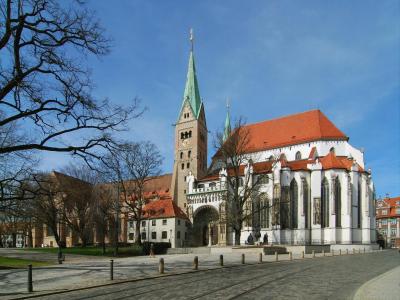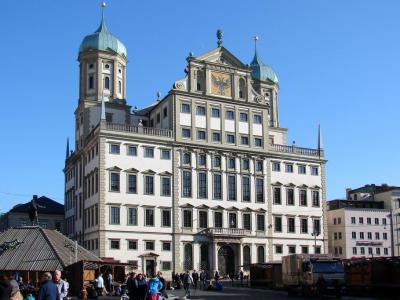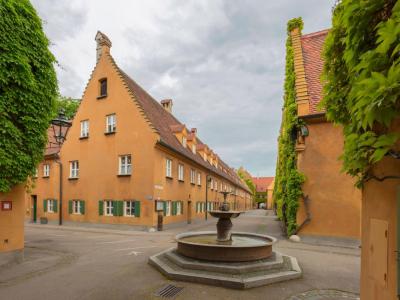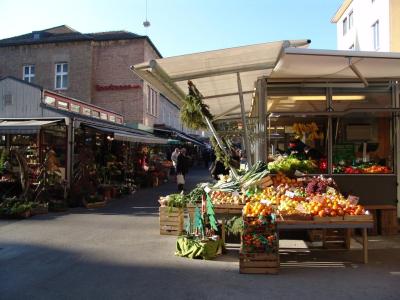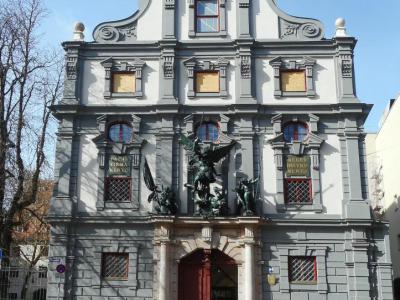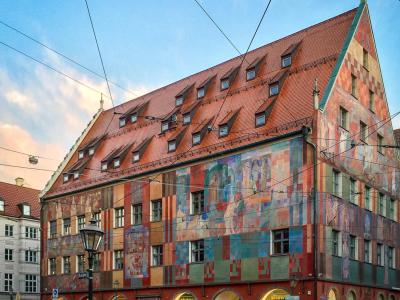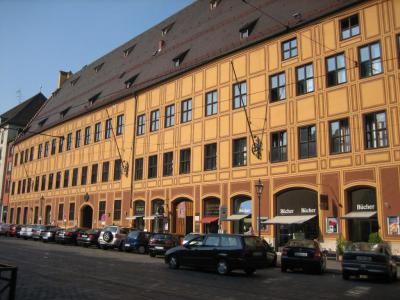Augsburg Introduction Walking Tour (Self Guided), Augsburg
Augsburg, one of Germany's oldest cities, was founded in 15 BC by the Romans as Augusta Vindelicorum and was named after the Roman emperor Augustus. Due to its strategic location on trade routes to Italy, Augsburg became a thriving commercial hub. It got the status of a Free Imperial City in 1276.
Throughout the 15th-16th centuries, Augsburg enjoyed prosperity driven by textile production, metalworking, and banking led among others by the affluent merchant family of Fugger. The Fuggerei, the oldest social housing complex in the world, was founded in 1513 by Jakob Fugger. Another remnant from that era, also built by the Fuggers, is the Fugger Houses (Fuggerhäuser).
Augsburg played a leading role in the Reformation as the site of the 1530 Augsburg Confession and the 1555 Peace of Augsburg. As the dominant center of early capitalism in Germany, it grew into one of the country's largest cities, excelling in manufacturing, publishing, and the arts. Rococo was so prevalent in the city that it became known as "Augsburg style" throughout Germany.
In the 17th century, Augsburg played a pivotal role in the European goldsmith network, attracting craftsmen from across the continent. The city also saw the formation of the League of Augsburg, a significant European coalition, in 1686. However, in 1806, with the dissolution of the Holy Roman Empire, Augsburg lost its independence and was annexed to Bavaria.
Strategically important during World War II, the city housed major Nazi military facilities and suffered significant Allied bombings resulting in considerable damage and casualties. After the war, its military barracks changed ownership, eventually serving as main US facilities during the Cold War.
Nowadays, among the top things to do in Augsburg is exploring on foot its historic center. Here, the Augsburg Cathedral (Augsburger Dom) stands tall as one of the city's most iconic structures. For a panoramic view of the cityscape, ascend the Perlach Tower (Perlachturm), a 70-meter-high marvel that offers breathtaking vistas of Augsburg's picturesque landscape. Nearby, the Augsburg Town Hall (Augsburger Rathaus) exemplifies the city's medieval charm, with its ornate Renaissance façade.
You can venture deeper into Augsburg's past by exploring the Basilica of Saints Ulrich and Afra revealing Augsburg's religious devotion.
If you are intrigued by Augsburg's compelling history and cultural heritage, set yourself forth on this self-guided adventure through the timeless landmarks, each holding a chapter in the city's storied past. For an avid history enthusiast or anyone seeking a taste of Bavaria's charm, Augsburg promises a truly enriching experience.
Throughout the 15th-16th centuries, Augsburg enjoyed prosperity driven by textile production, metalworking, and banking led among others by the affluent merchant family of Fugger. The Fuggerei, the oldest social housing complex in the world, was founded in 1513 by Jakob Fugger. Another remnant from that era, also built by the Fuggers, is the Fugger Houses (Fuggerhäuser).
Augsburg played a leading role in the Reformation as the site of the 1530 Augsburg Confession and the 1555 Peace of Augsburg. As the dominant center of early capitalism in Germany, it grew into one of the country's largest cities, excelling in manufacturing, publishing, and the arts. Rococo was so prevalent in the city that it became known as "Augsburg style" throughout Germany.
In the 17th century, Augsburg played a pivotal role in the European goldsmith network, attracting craftsmen from across the continent. The city also saw the formation of the League of Augsburg, a significant European coalition, in 1686. However, in 1806, with the dissolution of the Holy Roman Empire, Augsburg lost its independence and was annexed to Bavaria.
Strategically important during World War II, the city housed major Nazi military facilities and suffered significant Allied bombings resulting in considerable damage and casualties. After the war, its military barracks changed ownership, eventually serving as main US facilities during the Cold War.
Nowadays, among the top things to do in Augsburg is exploring on foot its historic center. Here, the Augsburg Cathedral (Augsburger Dom) stands tall as one of the city's most iconic structures. For a panoramic view of the cityscape, ascend the Perlach Tower (Perlachturm), a 70-meter-high marvel that offers breathtaking vistas of Augsburg's picturesque landscape. Nearby, the Augsburg Town Hall (Augsburger Rathaus) exemplifies the city's medieval charm, with its ornate Renaissance façade.
You can venture deeper into Augsburg's past by exploring the Basilica of Saints Ulrich and Afra revealing Augsburg's religious devotion.
If you are intrigued by Augsburg's compelling history and cultural heritage, set yourself forth on this self-guided adventure through the timeless landmarks, each holding a chapter in the city's storied past. For an avid history enthusiast or anyone seeking a taste of Bavaria's charm, Augsburg promises a truly enriching experience.
How it works: Download the app "GPSmyCity: Walks in 1K+ Cities" from Apple App Store or Google Play Store to your mobile phone or tablet. The app turns your mobile device into a personal tour guide and its built-in GPS navigation functions guide you from one tour stop to next. The app works offline, so no data plan is needed when traveling abroad.
Augsburg Introduction Walking Tour Map
Guide Name: Augsburg Introduction Walking Tour
Guide Location: Germany » Augsburg (See other walking tours in Augsburg)
Guide Type: Self-guided Walking Tour (Sightseeing)
# of Attractions: 12
Tour Duration: 2 Hour(s)
Travel Distance: 3.6 Km or 2.2 Miles
Author: DanaOffice
Sight(s) Featured in This Guide:
Guide Location: Germany » Augsburg (See other walking tours in Augsburg)
Guide Type: Self-guided Walking Tour (Sightseeing)
# of Attractions: 12
Tour Duration: 2 Hour(s)
Travel Distance: 3.6 Km or 2.2 Miles
Author: DanaOffice
Sight(s) Featured in This Guide:
- Augsburger Dom (Augsburg Cathedral)
- Perlachturm (Perlach Tower)
- Augsburger Rathaus (Augsburg Town Hall)
- Fuggerei
- Anna Street and City Market
- St. Anna Kirche (St. Anne's Church)
- Augsburger Zeughaus (Augsburg Armoury)
- Weberhaus (Weaver's House)
- Fuggerhauser (Fugger Houses)
- Basilika St. Ulrich und Afra (Basilica of Saints Ulrich and Afra)
- Augsburger Puppentheatermuseum (Augsburg Puppet Theater Museum)
- Rotes Tor (Red Gate)
1) Augsburger Dom (Augsburg Cathedral) (must see)
Augsburg Cathedral boasts a rich history that stretches back over a millennium. Its origins can be traced to the 8th century when it was initially established as a church.
The cathedral's architecture is a captivating fusion of Romanesque and Gothic elements, featuring stunning vaulted ceilings, intricate stonework, and soaring spires that reach towards the heavens. Its facade is adorned with sculptures, reliefs, and decorative detailing that reflect the artistic achievements of the era.
Within the cathedral, visitors can explore a treasure trove of religious relics and artworks. The cathedral houses numerous altarpieces, sculptures, stained glass windows, and religious artifacts that tell the story of Augsburg's deep religious heritage.
Augsburg Cathedral is dedicated to the Virgin Mary, the Mother of God, making her a central figure in the cathedral's religious narrative. Devotees and pilgrims come to pay homage to the Virgin Mary and seek her intercession.
The cathedral's architecture is a captivating fusion of Romanesque and Gothic elements, featuring stunning vaulted ceilings, intricate stonework, and soaring spires that reach towards the heavens. Its facade is adorned with sculptures, reliefs, and decorative detailing that reflect the artistic achievements of the era.
Within the cathedral, visitors can explore a treasure trove of religious relics and artworks. The cathedral houses numerous altarpieces, sculptures, stained glass windows, and religious artifacts that tell the story of Augsburg's deep religious heritage.
Augsburg Cathedral is dedicated to the Virgin Mary, the Mother of God, making her a central figure in the cathedral's religious narrative. Devotees and pilgrims come to pay homage to the Virgin Mary and seek her intercession.
2) Perlachturm (Perlach Tower)
The Perlach Tower has a history dating back to the late 10th century, making it one of Augsburg's oldest structures. It was originally built as part of the city's medieval fortifications, serving as a watchtower and a symbol of Augsburg's prominence as a trading and cultural hub.
The tower's architecture is a testament to the skill and craftsmanship of its builders. It features a distinctive blend of Romanesque and Gothic styles, characterized by its tall, slender design and intricate detailing. The tower stands approximately 70 meters (230 feet) tall, making it one of the tallest structures in Augsburg.
One of the highlights of visiting Perlachturm is ascending to its observation deck. From this elevated vantage point, visitors are treated to breathtaking panoramic views of Augsburg and its picturesque surroundings. It offers a unique perspective on the city's layout, historical buildings, and modern developments.
Perlachturm is adorned with a prominent clock that has been keeping time for centuries. The clock is not only a functional timepiece but also a charming addition to the tower's aesthetic. It serves as a reminder of Augsburg's enduring traditions and heritage.
Today, Perlachturm welcomes tourists and history enthusiasts from around the world. Visitors can explore the tower's interior, learn about its history through informative displays, and, of course, ascend to the observation deck for panoramic views.
The tower's architecture is a testament to the skill and craftsmanship of its builders. It features a distinctive blend of Romanesque and Gothic styles, characterized by its tall, slender design and intricate detailing. The tower stands approximately 70 meters (230 feet) tall, making it one of the tallest structures in Augsburg.
One of the highlights of visiting Perlachturm is ascending to its observation deck. From this elevated vantage point, visitors are treated to breathtaking panoramic views of Augsburg and its picturesque surroundings. It offers a unique perspective on the city's layout, historical buildings, and modern developments.
Perlachturm is adorned with a prominent clock that has been keeping time for centuries. The clock is not only a functional timepiece but also a charming addition to the tower's aesthetic. It serves as a reminder of Augsburg's enduring traditions and heritage.
Today, Perlachturm welcomes tourists and history enthusiasts from around the world. Visitors can explore the tower's interior, learn about its history through informative displays, and, of course, ascend to the observation deck for panoramic views.
3) Augsburger Rathaus (Augsburg Town Hall) (must see)
Augsburg Town Hall is a historic landmark with roots dating back to the Renaissance period. Its construction began in the early 17th century, and it has played a central role in the city's political and administrative life for centuries. The town hall's architectural style is a stunning blend of Renaissance and Baroque elements, showcasing intricate detailing, grand facades, and ornate embellishments. Its facade is adorned with statues, reliefs, and decorative motifs that reflect the artistic craftsmanship of the era.
One of the highlights of Augsburg Town Hall is its astronomical clock, known as the "Augsburger Perlachturm." This remarkable timepiece features intricate mechanisms and figurines that perform a captivating show at noon each day, attracting both locals and tourists.
Inside the town hall, visitors can admire a collection of frescoes and artwork that adorns its chambers and halls. These artistic creations provide insights into the history, culture, and achievements of Augsburg.
Augsburg Town Hall continues to serve as a functional government building, housing the city's administrative offices, council chambers, and other civic functions. Over the centuries, Augsburg Town Hall has been witness to numerous historic events, meetings, and gatherings, making it an integral part of the city's narrative.
Augsburg Town Hall is not only a center of civic activity but also a prominent tourist attraction. Visitors can take guided tours to explore the interior, admire the architecture, and learn about the town hall's role in Augsburg's past and present.
One of the highlights of Augsburg Town Hall is its astronomical clock, known as the "Augsburger Perlachturm." This remarkable timepiece features intricate mechanisms and figurines that perform a captivating show at noon each day, attracting both locals and tourists.
Inside the town hall, visitors can admire a collection of frescoes and artwork that adorns its chambers and halls. These artistic creations provide insights into the history, culture, and achievements of Augsburg.
Augsburg Town Hall continues to serve as a functional government building, housing the city's administrative offices, council chambers, and other civic functions. Over the centuries, Augsburg Town Hall has been witness to numerous historic events, meetings, and gatherings, making it an integral part of the city's narrative.
Augsburg Town Hall is not only a center of civic activity but also a prominent tourist attraction. Visitors can take guided tours to explore the interior, admire the architecture, and learn about the town hall's role in Augsburg's past and present.
4) Fuggerei (must see)
Fuggerei is a remarkable and historic enclave that holds the distinction of being the world's oldest social housing complex. In 2012, Fuggerei was recognized as a UNESCO World Heritage site, further cementing its status as a cultural and historical treasure.
Fuggerei was founded by Jakob Fugger the Younger, a member of the influential Fugger family, in 1516. His vision was to create a housing complex that would provide affordable homes for Augsburg's less fortunate citizens, particularly those in need.
Fuggerei was designed to be a self-contained community, consisting of modest yet comfortable apartments. The key feature of these dwellings is their remarkably low rent, which has remained virtually unchanged for centuries. To this day, residents pay a nominal annual rent of just one Rhenish guilder (equivalent to about one euro cent) plus three daily prayers for the Fugger family.
The architecture of Fuggerei reflects its Renaissance origins, with charming cobblestone streets, well-preserved facades, and picturesque courtyards. The houses are adorned with beautiful frescoes and decorative elements, offering a glimpse into the aesthetic sensibilities of the past.
Beyond housing, Fuggerei also includes a church, a hospital, and a small park, creating a self-sustaining environment where residents could lead a dignified life.
Remarkably, Fuggerei continues to operate based on Jakob Fugger's philanthropic vision. It remains a functioning housing complex for people with limited means, offering them an affordable place to live within a tranquil and supportive community.
Today, Fuggerei is not only a place to live but also a popular tourist attraction. Visitors are welcome to explore the historic enclave, stroll through its streets, and admire the architectural and historical significance of this enduring social experiment.
Fuggerei was founded by Jakob Fugger the Younger, a member of the influential Fugger family, in 1516. His vision was to create a housing complex that would provide affordable homes for Augsburg's less fortunate citizens, particularly those in need.
Fuggerei was designed to be a self-contained community, consisting of modest yet comfortable apartments. The key feature of these dwellings is their remarkably low rent, which has remained virtually unchanged for centuries. To this day, residents pay a nominal annual rent of just one Rhenish guilder (equivalent to about one euro cent) plus three daily prayers for the Fugger family.
The architecture of Fuggerei reflects its Renaissance origins, with charming cobblestone streets, well-preserved facades, and picturesque courtyards. The houses are adorned with beautiful frescoes and decorative elements, offering a glimpse into the aesthetic sensibilities of the past.
Beyond housing, Fuggerei also includes a church, a hospital, and a small park, creating a self-sustaining environment where residents could lead a dignified life.
Remarkably, Fuggerei continues to operate based on Jakob Fugger's philanthropic vision. It remains a functioning housing complex for people with limited means, offering them an affordable place to live within a tranquil and supportive community.
Today, Fuggerei is not only a place to live but also a popular tourist attraction. Visitors are welcome to explore the historic enclave, stroll through its streets, and admire the architectural and historical significance of this enduring social experiment.
5) Anna Street and City Market
Anna Street (Annastraße) is renowned as one of Augsburg's most popular shopping streets, attracting both locals and visitors. Here, you'll discover a wide array of stores, from fashionable designer boutiques to well-loved shoe shops and excellent bookstores. It's the perfect place to indulge in some retail therapy and explore the latest trends. The street is also famous for its department stores and grocery shops, where you can find an assortment of national delicacies.
As one of Augsburg's first paved streets, Anna Street has a rich history and a lively atmosphere that makes shopping here a delightful experience. The diverse range of stores ensures there's something for every shopper's taste and preference.
The City Market area (Stadtmarkt), accessed from Anna Street via an arcade, is a bustling market square that covers an impressive area of approximately 10,000 square meters (107,639 square feet). This vibrant market is a go-to destination for fresh produce, including an abundance of colorful fruits and vegetables.
The market is divided into two sections, each offering its own unique charm. On the eastern side, you'll find fixed market stalls where local vendors proudly display their wares. Here, you can explore a variety of products, including fresh meats, fish, baked goods, and more.
The western side of City Market is dedicated to agricultural products, adding to the market's agricultural charm. With a total of 104 shops, the market is a treasure trove of culinary delights, featuring departments such as the meat hall, Fischgasse (fish street), Viktualienhalle, Bäckergasse (baker's lane), Obstgasse (fruit street), Blumengasse (flower lane), Gemüsegasse (vegetable lane), and many more.
Whether you're strolling down Annastraße in search of the latest fashion trends or exploring Stadtmarkt Augsburg to savor the freshest produce, these vibrant destinations in Augsburg offer a blend of shopping, culture, and culinary delights that truly embody the spirit of the city.
As one of Augsburg's first paved streets, Anna Street has a rich history and a lively atmosphere that makes shopping here a delightful experience. The diverse range of stores ensures there's something for every shopper's taste and preference.
The City Market area (Stadtmarkt), accessed from Anna Street via an arcade, is a bustling market square that covers an impressive area of approximately 10,000 square meters (107,639 square feet). This vibrant market is a go-to destination for fresh produce, including an abundance of colorful fruits and vegetables.
The market is divided into two sections, each offering its own unique charm. On the eastern side, you'll find fixed market stalls where local vendors proudly display their wares. Here, you can explore a variety of products, including fresh meats, fish, baked goods, and more.
The western side of City Market is dedicated to agricultural products, adding to the market's agricultural charm. With a total of 104 shops, the market is a treasure trove of culinary delights, featuring departments such as the meat hall, Fischgasse (fish street), Viktualienhalle, Bäckergasse (baker's lane), Obstgasse (fruit street), Blumengasse (flower lane), Gemüsegasse (vegetable lane), and many more.
Whether you're strolling down Annastraße in search of the latest fashion trends or exploring Stadtmarkt Augsburg to savor the freshest produce, these vibrant destinations in Augsburg offer a blend of shopping, culture, and culinary delights that truly embody the spirit of the city.
6) St. Anna Kirche (St. Anne's Church)
Saint Anne's Church has a storied history that traces its roots back to the late 14th century when construction of the church commenced. The Church is dedicated to Saint Anne, the mother of the Virgin Mary and the grandmother of Jesus Christ.
The church is a splendid example of Gothic architecture, characterized by soaring vaulted ceilings, elegant arches, and intricate stonework. Its awe-inspiring facade is adorned with ornate sculptures and decorative detailing that reflect the artistic achievements of the era.
Within the church, visitors can explore a rich collection of religious relics and artworks, including altarpieces, sculptures, stained glass windows, and other sacred artifacts.
Located within the hallowed halls of Saint Anne's Church the Lutherstiege Museum is a captivating repository of religious and historical artifacts. This museum is dedicated to preserving and showcasing the legacy of the Protestant Reformation and its profound impact on the region. The museum pays tribute to the pivotal role played by Martin Luther and other reformers in shaping the course of religious history. Augsburg holds a special place in the history of the Reformation, as it was here that the Augsburg Confession, a foundational document of Lutheranism, was presented to Holy Roman Emperor Charles V in 1530.
Visitors to the Lutherstiege Museum can explore a diverse collection of exhibits, including original manuscripts, historical documents, religious texts, and artwork related to the Reformation era. Highlights of the collection may include Luther's writings, period-specific clothing, and items used in religious services during that time.
Adjacent to Saint Anne's Church is the Goldsmiths' Chapel, a magnificent testament to the artistry and craftsmanship of goldsmiths in Augsburg and a treasure trove of decorative art and religious devotion. The Goldsmiths' Chapel is renowned for its exquisite altar and ornate decorations, all created by the skilled hands of goldsmiths who were members of the Goldsmiths' Guild. The chapel's interior is adorned with intricate gold leafwork, precious metals, and delicate filigree, making it a stunning example of Renaissance artistry.
The church is a splendid example of Gothic architecture, characterized by soaring vaulted ceilings, elegant arches, and intricate stonework. Its awe-inspiring facade is adorned with ornate sculptures and decorative detailing that reflect the artistic achievements of the era.
Within the church, visitors can explore a rich collection of religious relics and artworks, including altarpieces, sculptures, stained glass windows, and other sacred artifacts.
Located within the hallowed halls of Saint Anne's Church the Lutherstiege Museum is a captivating repository of religious and historical artifacts. This museum is dedicated to preserving and showcasing the legacy of the Protestant Reformation and its profound impact on the region. The museum pays tribute to the pivotal role played by Martin Luther and other reformers in shaping the course of religious history. Augsburg holds a special place in the history of the Reformation, as it was here that the Augsburg Confession, a foundational document of Lutheranism, was presented to Holy Roman Emperor Charles V in 1530.
Visitors to the Lutherstiege Museum can explore a diverse collection of exhibits, including original manuscripts, historical documents, religious texts, and artwork related to the Reformation era. Highlights of the collection may include Luther's writings, period-specific clothing, and items used in religious services during that time.
Adjacent to Saint Anne's Church is the Goldsmiths' Chapel, a magnificent testament to the artistry and craftsmanship of goldsmiths in Augsburg and a treasure trove of decorative art and religious devotion. The Goldsmiths' Chapel is renowned for its exquisite altar and ornate decorations, all created by the skilled hands of goldsmiths who were members of the Goldsmiths' Guild. The chapel's interior is adorned with intricate gold leafwork, precious metals, and delicate filigree, making it a stunning example of Renaissance artistry.
7) Augsburger Zeughaus (Augsburg Armoury)
The Augsburg Arsenal, constructed in the early 17th century, was originally designed as a storage facility for an array of military equipment and supplies. The Augsburg Arsenal is a beautiful example of Renaissance architecture. Its façade is adorned with intricate stonework and finely crafted sculptures, showcasing the exquisite craftsmanship of its time. The sheer size and grandeur of the building make it a standout architectural gem.
Throughout its history, the Arsenal served as the epicenter of military affairs in Augsburg. It functioned as a vital nexus for the production, storage, and distribution of weapons, ammunition, and military equipment. It was a linchpin in the city's military endeavors. The Arsenal also housed various military forces, including the Bavarian army and the Imperial forces of the Holy Roman Empire.
Today, the Augsburg Arsenal welcomes visitors as a museum, offering a fascinating journey through the military history of Augsburg and the wider region. The museum's exhibits delve into the evolution of weaponry and military technology, the Arsenal's pivotal role in safeguarding the city, and the lives of the soldiers who served within its walls.
Visitors can explore the Arsenal's sprawling storage rooms, which once held vast quantities of weapons and essential supplies. Additionally, the museum provides insight into the inner workings of the Arsenal, including its workshops, barracks, and other facilities.
Throughout its history, the Arsenal served as the epicenter of military affairs in Augsburg. It functioned as a vital nexus for the production, storage, and distribution of weapons, ammunition, and military equipment. It was a linchpin in the city's military endeavors. The Arsenal also housed various military forces, including the Bavarian army and the Imperial forces of the Holy Roman Empire.
Today, the Augsburg Arsenal welcomes visitors as a museum, offering a fascinating journey through the military history of Augsburg and the wider region. The museum's exhibits delve into the evolution of weaponry and military technology, the Arsenal's pivotal role in safeguarding the city, and the lives of the soldiers who served within its walls.
Visitors can explore the Arsenal's sprawling storage rooms, which once held vast quantities of weapons and essential supplies. Additionally, the museum provides insight into the inner workings of the Arsenal, including its workshops, barracks, and other facilities.
8) Weberhaus (Weaver's House)
Dating back to 1389, the Weaver's House initially served as the headquarters of the weavers' guild until its dissolution in 1548. During the medieval era, it was a central hub for the textile trade in Augsburg. The original weavers' house underwent renovations, and its purpose evolved into the distribution of imported cotton among guild members. The building featured vibrant facade paintings, highlighting its historical importance.
Between 1605 and 1607, Matthias Kager, a renowned Augsburg city painter and mayor, adorned the outer wall with intricate frescoes. In April 1863, the Weberhaus was auctioned off, leading to a complete interior redesign. This transition included the removal of the wooden paneling in the guild room, painted by Peter Kaltenhoff in 1457. The Weberhaus subsequently became part of the Bavarian National Museum.
At the dawn of the 20th century, due to the deteriorating condition of the old weaver's house, it was eventually demolished, despite protests. In its place, a new building, designed by architect Otto Holzer and following a similar layout, was erected in 1913.
Prior to the demolition, remnants of original frescoes were uncovered on the outer facade, now preserved in the Maximilian Museum. Notably, the ceiling and wall paneling of the former guild room, considered one of the most extensive late Gothic picture cycles north of the Alps, were saved and relocated to the Bavarian National Museum in Munich.
The barrel vault within the Weberhaus boasts scenes featuring verses from the Old Testament and episodes from the life of Alexander the Great. The north wall showcases electors, emperors, and heroic figures, along with scenes from the story of creation. The east wall is adorned with depictions of Jewish prophets and pagan philosophers.
Between 1605 and 1607, Matthias Kager, a renowned Augsburg city painter and mayor, adorned the outer wall with intricate frescoes. In April 1863, the Weberhaus was auctioned off, leading to a complete interior redesign. This transition included the removal of the wooden paneling in the guild room, painted by Peter Kaltenhoff in 1457. The Weberhaus subsequently became part of the Bavarian National Museum.
At the dawn of the 20th century, due to the deteriorating condition of the old weaver's house, it was eventually demolished, despite protests. In its place, a new building, designed by architect Otto Holzer and following a similar layout, was erected in 1913.
Prior to the demolition, remnants of original frescoes were uncovered on the outer facade, now preserved in the Maximilian Museum. Notably, the ceiling and wall paneling of the former guild room, considered one of the most extensive late Gothic picture cycles north of the Alps, were saved and relocated to the Bavarian National Museum in Munich.
The barrel vault within the Weberhaus boasts scenes featuring verses from the Old Testament and episodes from the life of Alexander the Great. The north wall showcases electors, emperors, and heroic figures, along with scenes from the story of creation. The east wall is adorned with depictions of Jewish prophets and pagan philosophers.
9) Fuggerhauser (Fugger Houses)
Fugger Houses are a collection of historic townhouses located in Augsburg. These exquisite Renaissance-era buildings are not only architectural marvels but also a testament to the city's prosperous past and the influential Fugger family.
The Fugger family, one of the wealthiest and most prominent merchant and banking dynasties in Europe during the Renaissance, played a pivotal role in shaping Augsburg's history. Fugger Houses represent a stunning example of Renaissance architecture, characterized by their elaborate facades, ornate detailing, and harmonious proportions.
These townhouses feature beautiful courtyards, grand staircases, and opulent interiors. They are adorned with exquisite frescoes, decorative elements, and period-specific furnishings that offer visitors a glimpse into the opulence and aesthetics of the Renaissance era.
Fugger Houses consist of several interconnected buildings, each with its own unique character and purpose. They include Fugger House "Zum Mohren" (House of the Moor), Fugger House "Zum Tanz" (House of the Dance), and Fugger House "Zum Güldenen Stern" (House of the Golden Star).
The House of the Golden Star houses the Fugger Museum. This museum provides a comprehensive look into the history of the Fugger family, their business enterprises, and their contributions to Augsburg's cultural and economic development.
The Fugger family, one of the wealthiest and most prominent merchant and banking dynasties in Europe during the Renaissance, played a pivotal role in shaping Augsburg's history. Fugger Houses represent a stunning example of Renaissance architecture, characterized by their elaborate facades, ornate detailing, and harmonious proportions.
These townhouses feature beautiful courtyards, grand staircases, and opulent interiors. They are adorned with exquisite frescoes, decorative elements, and period-specific furnishings that offer visitors a glimpse into the opulence and aesthetics of the Renaissance era.
Fugger Houses consist of several interconnected buildings, each with its own unique character and purpose. They include Fugger House "Zum Mohren" (House of the Moor), Fugger House "Zum Tanz" (House of the Dance), and Fugger House "Zum Güldenen Stern" (House of the Golden Star).
The House of the Golden Star houses the Fugger Museum. This museum provides a comprehensive look into the history of the Fugger family, their business enterprises, and their contributions to Augsburg's cultural and economic development.
10) Basilika St. Ulrich und Afra (Basilica of Saints Ulrich and Afra) (must see)
The history of Basilica of Saints Ulrich and Afra can be traced back to the 9th century when it was initially founded as a Benedictine abbey. Over the centuries, it evolved into a significant religious institution in Augsburg.
The basilica showcases a magnificent blend of architectural styles, predominantly Romanesque and Gothic. Its awe-inspiring structure features stunning arches, intricate stonework, and soaring spires that reach towards the heavens.
Within the basilica, visitors can explore a rich collection of religious relics and artwork, including altarpieces, sculptures, and stained glass windows. These sacred artifacts serve as a testament to the deep-rooted religious traditions of the region.
The basilica is dedicated to Saints Ulrich and Afra, two revered figures in Augsburg's religious history. Saint Ulrich, a bishop, and Saint Afra, a martyr, are celebrated for their unwavering devotion to Christianity.
Beyond its religious significance, the basilica serves as a gathering place for the local community, hosting religious services, concerts, and cultural events that contribute to Augsburg's vibrant cultural scene.
The basilica showcases a magnificent blend of architectural styles, predominantly Romanesque and Gothic. Its awe-inspiring structure features stunning arches, intricate stonework, and soaring spires that reach towards the heavens.
Within the basilica, visitors can explore a rich collection of religious relics and artwork, including altarpieces, sculptures, and stained glass windows. These sacred artifacts serve as a testament to the deep-rooted religious traditions of the region.
The basilica is dedicated to Saints Ulrich and Afra, two revered figures in Augsburg's religious history. Saint Ulrich, a bishop, and Saint Afra, a martyr, are celebrated for their unwavering devotion to Christianity.
Beyond its religious significance, the basilica serves as a gathering place for the local community, hosting religious services, concerts, and cultural events that contribute to Augsburg's vibrant cultural scene.
11) Augsburger Puppentheatermuseum (Augsburg Puppet Theater Museum)
The Augsburg Puppet Theater Museum is dedicated to celebrating the art and history of puppetry, providing visitors with a captivating journey into the world of marionettes, hand puppets, and theatrical craftsmanship.
Visitors to the museum can explore a diverse array of puppet collections, each offering a unique perspective on the art form. The museum features intricate theatrical displays that recreate scenes from classic puppet performances. These displays allow visitors to experience the magic of puppet theater up close.
Some sections of the museum may include interactive exhibits where visitors can try their hand at puppet manipulation, learning the techniques used by puppeteers to bring characters to life.
The museum may host cultural events, puppet shows, workshops, and exhibitions related to the world of puppetry, creating an immersive experience for visitors.
The Puppet Theater Museum is part of the Augsburg Puppet Box - a renowned puppet theater and cultural institution founded in 1948. The theatre has a rich history dating back to its founding by puppeteer Walter Oehmichen. Over the decades, it has established itself as one of Germany's most renowned puppet theaters, captivating audiences with its imaginative performances.
Visitors to the museum can explore a diverse array of puppet collections, each offering a unique perspective on the art form. The museum features intricate theatrical displays that recreate scenes from classic puppet performances. These displays allow visitors to experience the magic of puppet theater up close.
Some sections of the museum may include interactive exhibits where visitors can try their hand at puppet manipulation, learning the techniques used by puppeteers to bring characters to life.
The museum may host cultural events, puppet shows, workshops, and exhibitions related to the world of puppetry, creating an immersive experience for visitors.
The Puppet Theater Museum is part of the Augsburg Puppet Box - a renowned puppet theater and cultural institution founded in 1948. The theatre has a rich history dating back to its founding by puppeteer Walter Oehmichen. Over the decades, it has established itself as one of Germany's most renowned puppet theaters, captivating audiences with its imaginative performances.
12) Rotes Tor (Red Gate)
The Red Gate is one of the remaining gates of Augsburg's medieval city walls, which once served as protective fortifications. It was originally constructed in the late 14th century, making it several centuries old. The gate played a crucial role in defending the city during tumultuous times.
The gate is known for its distinctive red color, which is where its name, Rotes Tor, originates. Its vibrant hue sets it apart from the surrounding architecture and adds to its visual appeal.
The Red Gate features a striking tower with an imposing presence. Its architectural design reflects the Gothic style of the late Middle Ages, characterized by pointed arches and intricate detailing. The tower's structure is a testament to the craftsmanship of the era.
While Red Gate no longer serves its original defensive function, it serves as a gateway for modern visitors to step back in time and explore Augsburg's medieval history.
The gate is known for its distinctive red color, which is where its name, Rotes Tor, originates. Its vibrant hue sets it apart from the surrounding architecture and adds to its visual appeal.
The Red Gate features a striking tower with an imposing presence. Its architectural design reflects the Gothic style of the late Middle Ages, characterized by pointed arches and intricate detailing. The tower's structure is a testament to the craftsmanship of the era.
While Red Gate no longer serves its original defensive function, it serves as a gateway for modern visitors to step back in time and explore Augsburg's medieval history.
The Most Popular Cities
/ view all



